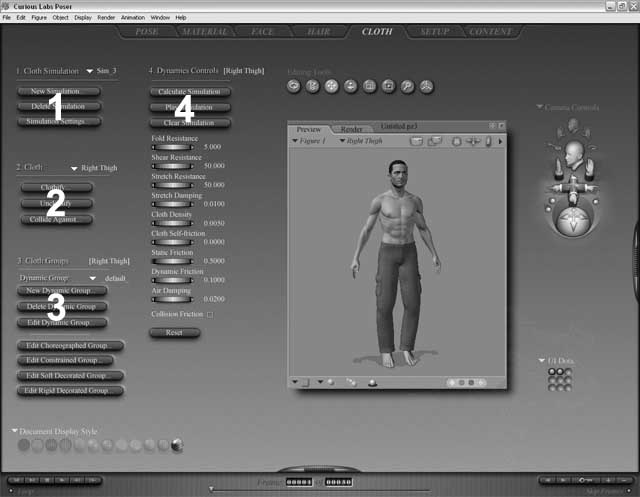Cloth Room Help:
NOTE: Refer to your Poser Reference Manual for additional Cloth room information.
The Cloth room appears as follows:

In addition to standard UI elements, the Cloth room contains the following UI elements:
- Cloth Simulations: The Cloth Simulation area (1) allows you to create, delete, and set up cloth simulators.
- Cloth: The Cloth area (2) allows you to convert objects to and from Poser cloth objects and to set up collision detection for your cloth.
- Cloth Groups: The Cloth Groups area (3) is where you set up dynamic, choreographed, constrained, and decorated cloth groups.
- Dynamics Controls: The Dynamics Controls group (4) sets up dynamic parameters.
Conforming vs. Dynamic Cloth
Conforming clothing is treated like a Poser 4 figure. Dynamic cloth adds incredible realism to your scenes by causing cloth objects to move as they would in real life but requires increased computing resources beyond those of conforming clothing. Tight-fitting clothing such as socks, bikinis, tights, etc. donít need to be dynamic.
To create dynamic cloth:
- Create/set up a cloth simulator
- Clothify props
- Create/edit cloth groups
- Set up Dynamics
Adding Poser Dynamic Cloth to the Library Palette
To add dynamic cloth to the Library palette:
- If not done yet, load your desired figure and be sure to disable Inverse Kinematics. Next, open the Joint Editor palette and click the Zero Figure button.
- If not loaded yet, load or import your desired cloth object and ensure it fits the figure without obvious intersections. If importing a static prop, convert it into dynamic cloth.
- Select the cloth, then open its Properties palette and click the Set Parent button (or select Object>Set Parent).
- The Choose Parent window appears. Select Hip, being sure not to check the Inherit bends of parent checkbox.
- Open the Library palette to the Props>Dynamic Cloth category and select your desired subcategory as described above. Save the cloth object.
- You will be prompted to save the object as a smart prop. Click Yes.
NOTE: If your cloth object is not tied to a figure (such as a tablecloth), simply save it as a prop.

